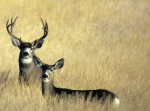Fire shift wildlife migrations; long-term effect is positive

The 150,000-acre Trinity Ridge Fire in the mountains of central Elmore County this year will force some changes in the normal migration patterns of big game, but overall may actually benefit the wildlife of the area, Idaho Department of Fish and Game officials say.
Using lessons learned from the massive 1988 Yellowstone fires, wildlife biologists believe the long-term effect on the forest will be positive.
In the several years following the Yellowstone fires, "ample precipitation combined with the short-term effects of ash and nutrient influx to make for spectacular displays of wildflowers in burned areas," the forest service said, "and, where lodgepole pines were burned, seed densities ranged from 50,000 to 1 million per acre, beginning a new cycle of forest growth under the blackened canopy above."
Although the winter range forage for several major elk herds were severely damaged or totally destroyed in the Trinity Ridge Fire this year, ground cover is expected to recover rapidly over the next two years. That "new" forage is typically more nutritious and easier to access. The Yellowstone fires showed that elk and deer populations exploded about two years after the fire. In the following years, the high-end predators, such as wolves, cougars and bears, also saw significant increases in numbers.
Very few animals were lost in the Trinity Ridge Fire. The blaze moved slow enough in most cases that animals could get out of the way and it began late enough in the season that even young animals born in the spring were mobile enough to avoid the fire.
But it's the loss of winter range "that's the most important thing right now," said F&G Conservation Officer Bob Sellers. "It could really change some elk migration patterns."
Fellow Conservation Officer Jeff Day said he expects the elk will be moving down out of the mountains and into the lower elevations earlier than normal this year.
Not everything, Day said, was totally destroyed by the Trinity Ridge Fire, so there is some forage available for early winter. "It hasn't been nuked. A lot of it (the fire area) is a mosaic," he said, with some sections charred and others relatively unscathed.
But whether or not hunters will be allowed in the fire area by the Forest Service is still unknown, Day said when interviewed in mid-September. Many of the trails in the area are considered dangerous because of damaged trees that could fall on a hunter, although the Forest Service is working hard to clear those trails.
The biggest impact of the fire, Day believes, will be on area corn farmers when the elk move down out of the mountains early. Because of large subsidies by the federal government for ethanol, many farmers have switched their crops to corn in recent years, and "corn is like candy to an elk. They'll head straight for it," Day said. "We're already seeing problems up on the Camas (prairie)."
The fire already has affected the elk archery season because large parts of Unit 43 burned, putting heavy hunting pressure on the remaining parts of the unit. But while large parts of Unit 39 burned as well, Day said, "that's a huge unit, so there's still plenty of room there."
None of the Fish and Game officials contacted were considering any high likelihood of special depredation hunts this year due to the fires, however. "It's a little early to tell, but right now I don't see it," Day said.
He did remind hunters that closures still remain in effect for the areas burned last year in the Teapot Dome and Blair fires.
